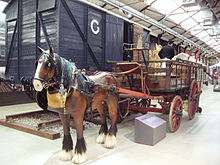- Drayage
-
In the shipping industry and logistics, drayage is the transport of goods a short distance, [1] often as part of a longer overall move. A drayage trip can typically be completed in a single work shift. The term drayage is also used for the fee paid for such services.
The term originally meant "to transport by a sideless cart," or dray. Such carts, pulled by dray horses, were used to move goods between ships or railroad cars and factories, warehouses and shops.
Examples
In Intermodal freight transport, drayage [2] is the transport of containerized cargo by specialized trucking companies[3] between ocean ports or rail ramps and shipping docks. In terms of logistics, a dray is when a container or piggyback is moved from a rail yard to another location, such as a Logistics Depot Distribution Center, and then returning that piggyback/container back to the initial pick-up point. It is important that these containers get unloaded quickly and returned back to the original point so not to incur detention charges.
Drayage service is sometimes used in trade shows, where a large number of vendors gather in a large exhibition area with a large number of products. Because of the sheer volume of goods, it would create mass confusion if the individual vendors transported their own goods and equipment into the site. Convention centers and hotels do not have the facilities, equipment, or manpower to manage the receiving and storing of all the exhibit freight. Thus, the exhibit sponsor assigns and recommends a drayage service for the entering and exiting of freight and products.
Drayage service is usually provided by a national trucking/shipping company or an International shipment brokerage firm in addition to the transportation of the freight to and from the exhibit site. Drayage service provides for:
- Completing inbound carrier's receiving documents.
- Unloading and delivery of the goods to your booth/stand space from the receiving dock
- Storing of empty cartons/crates and extra products at a on/near-site warehouse
- Pickup of the goods from your booth/stand space to the receiving dock and loading back into the carrier
- Completing outbound carrier's shipping documents.
In many malls and shopping streets where there are many retailers gathered in the same building or street, and it would be too difficult for a delivery company like UPS or FedEx to maneuver their vehicles to all the locations because of parking restrictions or pedestrianization measures. Instead, the mall or street association prepares a drayage area, in a convenient location, where all packages from the tenants and couriers are collected and distributed by a service by the association. This is similar to a mail room facility at large corporations.
References
- ^ http://www.thefreedictionary.com/drayage
- ^ Bloomberg.com: Financial Glossary
- ^ Advances At CSX Intermodal - Forbes.com

This transport corporation-related article is a stub. You can help Wikipedia by expanding it.


